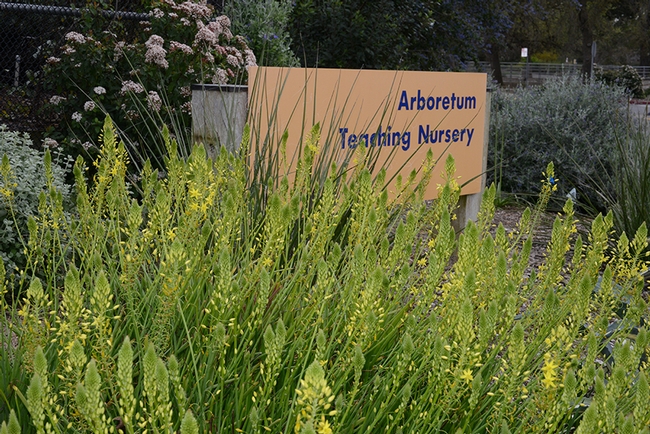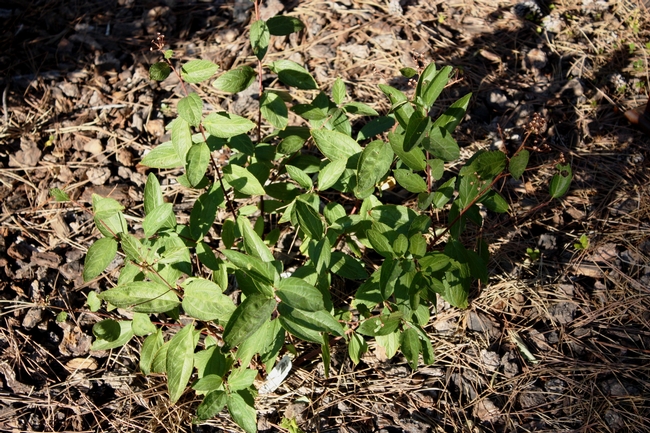Posts Tagged: ceanothus
Plant 'em and They Will Come
In the movie, "Field of Dreams," an Iowa corn farmer hears a voice whispering "If you build it, he will come." Apparently thinking this is the voice...

A honey bee forages on a ceanothus (California lilac) in the UC Davis Arboretum. (Photo by Kathy Keatley Garvey)

A honey bee takes a liking to white flowering quince in the White Garden, UC Davis Arboretum. (Photo by Kathy Keatley Garvey)

The UC Davis Arboretum Teaching Nursery will be the site of a Member Appreciation Sale on Saturday, March 12. Prospective members can join at the door. (Photo by Kathy Keatley Garvey)
The California Stunner
As our dry winter continues, I feel the need to drag out my soapbox once again. Isn’t it time we got real about drought-tolerant landscaping? I am not advocating severe rock-and-cactus plantings. I’m suggesting some serious consideration of California native plantings.
March is the perfect month for us to take notice of the beauty of California native plants. Poppies and lupines are coloring hillsides all across the state. Manzanitas are dotted with tiny whitish blooms. Our stately blue oaks are budding out. Ceanothus is blooming cool blue from the coast to the foothills. And all this glory comes along without supplementary irrigation!
Have you noticed the other California stunner? The Western redbud (Cercis occidentalis) is dazzling right about now, its leafless branches covered in magenta blooms. You can see the shrubs along roadsides and freeways throughout Solano, Yolo and Sacramento counties. They’re particularly beautiful on the road to Lake Berryessa.
Now this is a native I can really get behind. It is easy to grow, though a bit slow. It’s not too picky about soil, but seems to be happiest on a well-drained, sunny hillside. It is deciduous, but with year-round interest (magenta blossoms now, burgundy heart-shaped leaves in spring, seedpods throughout winter). It can be trained into a smallish tree (8-20 feet), or left to its shrubby natural growth patterns. Not much bothers redbuds. The best part, in my opinion: Once a Western redbud is established in your landscape, it does not require extra irrigation. You might attain faster growth with occasional summer water, but the tree will do just fine without.
How cool is that?

Blooming stands of Western redbud can be found in March along Pleasants Valley Road in rural Vacaville. (photo by Kathy Thomas-Rico)
UC Davis Arboretum Plant Sale
Last year, I went to a UC Davis Arboretum plant sale and found many plants that I wanted for my garden. They had so many different plants that it was hard to decide what to choose for my garden. I found some different ceanothus, some crape myrtle, a chocolate scented plant with yellow flowers and many others. I ended up buying over 15 plants and am enjoying all of them except the chocolate scented plant which did not survive our frost last winter.
The sale has hundreds of different kinds of uncommon garden plants that have been locally grown, including the Arboretum All-Star plants, their top recommended plants for gardens in our Mediterranean-type climate. Expert advice is also available to help you choose the right plants for your garden.
Their next plant sale is on Sunday, October 9 from 9 am to 1 pm with a focus on sustainable gardens. There will be a plant doctor clinic so you can bring your problem plants sealed in a plastic bag for diagnosis. The plant sales are at the UC Davis Arboretum Teaching Nursery on Garrod Drive at the University of California in Davis. For more information, go to
http://arboretum.ucdavis.edu/plant_sales_and_nursey.aspex


